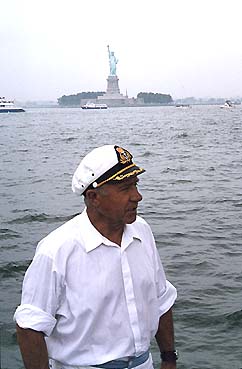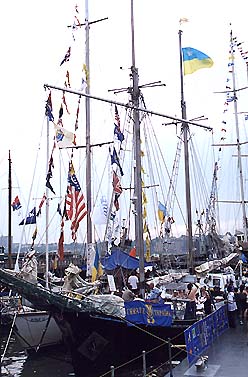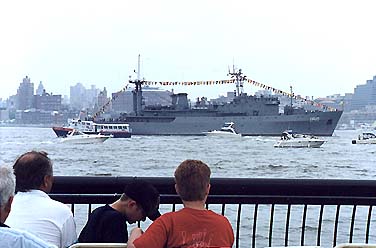
"Discover Ukraine" expedition discovers America
Our Kyiv Bureau Editor Roman Woronowycz, who has written on the Discover Ukraine project and the Batkivschyna schooner for nearly two years, was invited by the expedition's organizers, whom he has come to know well, to take part in a portion of the journey, and to be on board when the vessel entered New York harbor on the Fourth of July for the Parade of Sail and International Naval Review. He first joined the crew outside Wilmington, Del., on June 29 as they sailed down the Delaware Bay and left them five days later after the parade was over and the vessel had docked in Midtown Manhattan. The following is his account of the voyage as recounted by the captain and members of the crew and expedition.
by Roman Woronowycz
ABOARD THE BATKIVSCHYNA - On a humid and hazy Fourth of July, with U.S. military air power flying overhead and President Bill Clinton present aboard the aircraft carrier USS John F. Kennedy, Operation Sail 2000, the largest maritime event in history, entered New York Harbor. And with it came the Ukrainian yacht, the Batkivschyna.
Among the 180 or so officially registered exotic tall ships and military vessels, and another 4,000 pleasure craft that have gathered for this celebration of the new millennium, the 89-foot gaff schooner with its cement hull is not particularly remarkable, either in its appearance or its technology. However, the travails that it and its crew endured during the three-month, 8,000-mile voyage from Kyiv to the United States has turned its presence on the Eastern Seaboard of the United States into something of a sensation.
Major newspapers and broadcast outlets in New York, Maryland, Virginia and Delaware have given comprehensive coverage to the journey of the Batkivschyna and the hurdles it had to jump, including directional and communications problems that caused the ship to end up thousands of miles off course, spring storms that forced one member of the 16-person crew to leave before the voyage even reached the Atlantic, a broken toilet, international incidents and perhaps the project's most persistent headache, a lack of funds.

Dymytrii Birioukovitch, captain of the Batkivschyna
and director of the Discover Ukraine expedition.
Roman Woronowycz
While the schooner officially left port in Kyiv on April 7, preparations for the journey began about a year earlier, and included planning to fulfill the captain's main objective: to let the world know about Ukraine.
Officially dubbed the "Discover Ukraine" project, the point was to turn the Batkivschyna into a floating information center on Ukraine's history, culture, geography and current business opportunities. Seventeen story boards were prepared and printed; an audio presentation was developed; a display of children's artwork was organized, music was selected and recorded; crew members who could properly represent the project were chosen, including an actual member of the Kozak Brotherhood of Ukraine.
There also was an agreement with Kirk Middle School in Wilmington, Del., for satellite and Internet link-up between the school and the ship, which the junior high-schoolers would undertake as a project on Ukrainian history, geography and culture. That program, which had technical difficulties from the start, was abbreviated after the ship's shore communications died.
The Discover Ukraine idea was the brainchild of the ship's captain, Dymytrii Birioukovitch. A civil engineer by profession, but also a lifelong sailing enthusiast, in 1989 Capt. Birioukovitch claimed the carcass of an old fishing vessel that had sailed the waters of the Black Sea since the 1950s, but had been discarded on an island in the Dnipro River several years back. Within two years he had refitted and repainted it, turning it into an ocean-worthy sailing vessel he named the Batkivschyna, which means fatherland.
Since then, the ship and the captain had sailed the Dnipro River, the Black Sea and the Mediterranean to Western Europe and the Middle East several times. It was on one of those trips that Capt. Birioukovitch came up with his idea to let the world know about Ukraine.
"We were docked in Israel, on the Red Sea, and people kept coming up to me asking me what country was represented by the flag under which we were sailing," said Capt. Birioukovitch. "It was then that I understood that we needed to let the world know that our country exists."
The original idea was to sail the world with stops at key cities and countries, where the presentations would take place both on the ship and off. But the lack of money, the project's essential Achilles' heel from the start, de-railed that plan almost immediately. Potential contributors simply never followed through on promises of financial support. At the government level, Batkivschyna eventually was given "official" status as the representative of Ukraine for OpSail 2000, but Kyiv, too, failed to offer financial support. The schooner, along with the Slavutych, staff ship of the Ukrainian navy, made up the official Ukrainian contingent to the OpSail 2000 celebration.

The Ukrainian schooner, the Batkivschyna.
Roma Hadzewycz
Undeterred, Capt. Birioukovitch and his partners, a Kyiv businessman named Roman Malarchuk and Roy Kellogg, a Canadian businessman and attorney who happens to be married to the captain's daughter, decided to change strategy. Instead of the world, they would focus on Western Europe and take up an offer from El Ferrol, Spain, to travel there for the annual Santiago Festival. It still would be a transglobal project, but now would be done in stages.
Their success in Spain led to an invitation from the Office of the President of the United States to take part in OpSail 2000. Again a shortage of funds brought near panic and crisis to the captain and his partners as their scheduled April 2 departure date approached. However, OpSail organizing committees in Baltimore and Norfolk and the central organizing committee in Washington, as well as individual donors came through with some $10,000 in the last weeks, which gave the project funding for basic supplies and fuel.
On April 7 they finally departed, five days behind schedule but fully ready to set people straight on what their country is all about.
Again, however, things were not meant to go smoothly. Spring came late to Ukraine this year with ice flows still dotting the Dnipro River in April. The unseasonably cold weather forced a postponement in the opening of the locks on the Dnipro River that are found just below Cherkasy. The crew waited only a day, but that irritation was followed by another incident in which they broke a toilet when the Batkivschyna hit a sand bar, after an unobservant helmsman failed to note it.
Having replaced their "head" near Kherson, they were off again, only to be preceded by an international incident between Turkey and Ukraine. As they sailed down the river to the Black Sea, a Turkish fishing vessel was sunk after attempting to flee from a Ukrainian coast guard vessel that had discovered its illegal presence in Ukrainian territorial waters.
With tempers tattered in Kyiv and Istanbul, Capt. Birioukovitch decided to bypass a scheduled stop for fuel in the Turkish capital and move directly into the Mediterranean.
With warmer weather, the crew - which consisted of 13 young sailors, including one 21-year-old woman, plus the captain, his wife, Nina, and their 14-year-old grandson, Vadym - relaxed for the first time since leaving. But the warm air in the Mediterranean brought another problem: the spring storms.
The crew all suffered the effects of the large sea swells and strong head winds that rocked the vessel for two days near Corsica, which even managed to force one of the crew off the ship.
Still more troubles ensued when their ship's shortwave radio failed even before it entered the Atlantic Ocean. To add to the crews growing woes, the firm that provided them with their satellite phone hook-up went out of business soon afterwards, which effectively cut their last line of direct communication with the outside world.
If all this was not enough, their global positioning system (GPS) seemed to go awry, and suddenly they discovered that they were far off track. Days before the May 25 opening of OpSail 2000 in Puerto Rico, a date they had planned to make, the ship was somewhere in the Atlantic Ocean between the Bermudas and the Azore Islands.
Mr. Kellogg, one of the Discover Ukraine's other directors, who was in charge of the advance team, summoned the U.S. Coast Guard in San Juan after it became apparent that the ship was late. After an unsuccessful initial search within a 250-mile radius of the U.S. territory, the hunt for the lost vessel was expanded to the coast of Africa.
However, at about the same moment, Capt. Birioukovitch, fully aware that he was late and that people were probably getting worried, finally made contact with a vessel in the vicinity of his ship and gave word that the Batkivschyna had corrected course and was okay. He decided, however, to proceed directly to Norfolk, Va., for the third leg of the OpSail, bypassing both San Juan and the second scheduled stop, Miami.
"The most difficult time of our trip was when we knew that people were waiting for us, and we couldn't contact them," explained Capt. Birioukovitch.
He underscored that at no time was there any danger to the crew's safety and that the vessel, with its emphasis on utility and not aesthetics, held up admirably well through all parts of the voyage.
The expedition's luck changed for the better once it finally hit Norfolk, Va., on June 5. Donations of money and goods, including a gift of 2.5 tons of badly needed diesel fuel, as well as a new VHS radio communication system helped boost moral.
On shore, large crowds, fine weather and plenty of hospitality mended the frayed nerves of the crew, which had not only to deal with the dearth of communications during their voyage, but also with the tensions that develop when people are thrown into close quarters in less than optimal conditions.
Capt. Birioukovitch said he has been amazed at the attention and the outpouring of support not only from Ukrainian Americans but by many others as well. He was particularly delighted with the attention paid his yacht and crew in Chesapeake, Va., where the Batkivschyna waited for OpSail 2000 to catch up to them.
"They supported us like we were family," explained Capt. Birioukovitch. "Our diaspora was at the center of it all, of course, but all sorts of Americans helped us without regard to age, sex, or whatever."
In Wilmington the kids from Kirk Middle School turned out and, of course, there was another tall ship parade.
Then it was on to Baltimore, where more celebrations occurred, another parade took place, and more greetings and well wishes from Ukrainian Americans and others were expressed.
When not in parade, the crew members took turns at the helm, relaxed, helped prepare dinner, manned the sails or simply relaxed and took a much-deserved rest.
The cook had the hardest time of it, according to the captain. "At the helm, you must be attentive, but you can relax and enjoy the scenery for the most part," he explained. "But in the galley it is hot and it is wet, and you have to do it three times a day, because we have to eat."
The sail down the Delaware Bay after the conclusion of the Baltimore program and then up the coast of the Atlantic Ocean was probably the most relaxed portion of the trip thus far. It gave the captain the ability to anchor the boat to allow the crew and several guests time to take dips in the water and also to accept an unexpected invitation for his crew to come ashore for lunch at the home of a Ukrainian American who resides on the bay.

The Slavutych, staff ship of the Ukrainian navy,
anchored on the Hudson River off Hoboken, N.J., during Operation Sail 2000.
Roma Hadzewycz
In New York hundreds of thousands turned out on July 4 to greet the Batkivschyna and the other ships of OpSail 2000 and watch them sail in formation beneath the Verrazano Bridge, past the Statue of Liberty, into the Hudson River and finally toward the George Washington Bridge, which connects upper Manhattan with New Jersey. As the Batkivschyna came into the Hudson River covered in an eerie morning mist, Capt. Birioukovitch, hands at the helm and his white captain's hat upon his head, turned to no one in particular and with a broad grin exclaimed, "This is what it's all about, my friends. This is what we came for."
After turning, the vessel entered its slip on Pier 86, located near the USS Intrepid on 44th Street and 12th Avenue, where large crowds queued up to the Batkivschyna's plank and waited for their chance to come aboard.
While the captain signed autographs on deck and accepted donations, a Kozak entertained the crowds with an accordion and a flute that resembled a flintlock pistol.
As the crowds subsided and as the sun set, Capt. Birioukovitch said that, although he realized there was still much travel and parading left, he knew that without the help of Ukrainian Americans the trip would have proved much more difficult, if not impossible, to complete.
"Please express my sincere gratitude to all. I realize that not everyone can be named. And please, let everyone understand that I am thankful for more than strictly the material assistance; I see the support as support for what we want to convey here," said Capt. Birioukovitch.
The Batkivschyna leaves New York on July 9 and moves to New London, Conn., where some are expecting the largest and most organized reception by the Ukrainian American community yet. Then it is on to Portland, Maine, where OpSail concludes at the end of the month before the ship and the crew return to Philadelphia, where they have been invited to take part in Ukrainian Independence Day celebrations.
Afterward the captain hopes to sail on to Halifax, Nova Scotia, and then, if he can gather the financial support and find a place to store his vessel during the winter, he would like to spend some time on the Great Lakes.
In the spring, if financing allows for it, the Batkivschyna, Captain Birioukovitch and the Discover Ukraine expedition plan to continue their transglobal odyssey.
The Batkivschyna sails into New York: a photo report
Copyright © The Ukrainian Weekly, July 9, 2000, No. 28, Vol. LXVIII
| Home Page |